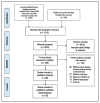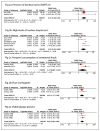Risk Factors for Early Childhood Caries: A Systematic Review and Meta-Analysis of Case Control and Cohort Studies
- PMID: 30992106
- PMCID: PMC7100045
Risk Factors for Early Childhood Caries: A Systematic Review and Meta-Analysis of Case Control and Cohort Studies
Abstract
Purpose: The purpose of this study was to perform a systematic review to assess current evidence for association between various risk factors and the prevalence or incidence of early childhood caries (ECC). Methods: Two reviewers searched various databases until January 2019. The Newcastle-Ottawa scale was used to perform risk of bias assessment. The included studies were categorized according to the World Bank classification. Data were summarized in a meta-analysis using fixed and random effects inverse-generic meta-analyses. Results: A total of 7,034 records involving 89 studies that evaluated 1,352,097 individuals were included; 23 were high, 46 were moderate, and 20 were of low quality. A total of 123 risk factors were found. Meta-analysis revealed that the strongest risk factors found in the high-income countries were presence of dentinal caries (dmft greater than zero; odds ratio [OR] equals 4.21 [2.18 to 8.16]) and high levels of mutans streptococci (OR equals 3.83 [1.81 to 8.09]). In upper-middle-income countries, presence of enamel defects (OR equals 14.62 [6.10 to 35.03]) was found to be the strongest risk factor. Conclusion: The strongest risk factors associated with early childhood caries was the presence of enamel defects, presence of dentinal caries and high levels of mutans streptococci.
Figures



Similar articles
-
Is Mutans Streptococci count a risk predictor of Early Childhood Caries? A systematic review and meta-analysis.BMC Oral Health. 2023 Sep 7;23(1):648. doi: 10.1186/s12903-023-03346-8. BMC Oral Health. 2023. PMID: 37679718 Free PMC article.
-
Risk Factors for Early Childhood Caries: An Umbrella Review.Pediatr Dent. 2021 May 15;43(3):176-194. Pediatr Dent. 2021. PMID: 34172110
-
The relationship of enamel defects and caries: a cohort study.Oral Dis. 2011 May;17(4):420-6. doi: 10.1111/j.1601-0825.2010.01770.x. Epub 2010 Nov 29. Oral Dis. 2011. PMID: 21114593
-
Salivary mutans streptococci and dental caries patterns in pre-school children.Community Dent Oral Epidemiol. 1996 Jun;24(3):164-8. doi: 10.1111/j.1600-0528.1996.tb00835.x. Community Dent Oral Epidemiol. 1996. PMID: 8871013
-
Dental caries and enamel defects in very low birth weight adolescents.Caries Res. 2010;44(6):509-18. doi: 10.1159/000320160. Epub 2010 Oct 26. Caries Res. 2010. PMID: 20975268 Free PMC article.
Cited by
-
Risk Factors of Early Childhood Caries Among Preschool Children in Eastern Saudi Arabia.Sci Prog. 2021 Apr-Jun;104(2):368504211008308. doi: 10.1177/00368504211008308. Sci Prog. 2021. PMID: 33861673 Free PMC article.
-
Risk Indicators for Early Childhood Caries in South Africa: Protocol for a Systematic Review.JMIR Res Protoc. 2021 Jun 25;10(6):e26701. doi: 10.2196/26701. JMIR Res Protoc. 2021. PMID: 34170258 Free PMC article.
-
Relationship Between Mutans Streptococci and Lactobacilli in the Oral Cavity and Intestine of Obese and Eutrophic Children With Early Childhood Caries-Preliminary Findings of a Cross-Sectional Study.Front Pediatr. 2020 Dec 11;8:588965. doi: 10.3389/fped.2020.588965. eCollection 2020. Front Pediatr. 2020. PMID: 33363062 Free PMC article.
-
Effect of a Short-Term Intervention with Lactobacillus salivarius Probiotic on Early Childhood Caries-An Open Label Randomized Controlled Trial.Int J Environ Res Public Health. 2022 Sep 29;19(19):12447. doi: 10.3390/ijerph191912447. Int J Environ Res Public Health. 2022. PMID: 36231747 Free PMC article. Clinical Trial.
-
Maternal and infant risk factors and risk indicators associated with early childhood caries in South Africa: a systematic review.BMC Oral Health. 2022 May 18;22(1):183. doi: 10.1186/s12903-022-02218-x. BMC Oral Health. 2022. PMID: 35585594 Free PMC article.
References
-
- Ostberg AL, Skeie MS, Skaare AB, Espelid I. Caries increment in young children in Skaraborg, Sweden: associations with parental sociodemography, health habits, and attitudes. Int J Paediatr Dent. 2017;27(1):47–55. - PubMed
-
- Marthaler TM. Changes in dental caries 1953-2003. Caries Res. 2004;38(3):173–81. - PubMed
-
- Geyer S, Schneller T, Micheelis W. Social gradients and cumulative effects of income and education on dental health in the Fourth German Oral Health Study. Community Dent Oral Epidemiol. 2010;38(2):120–8. - PubMed
Publication types
MeSH terms
Grants and funding
LinkOut - more resources
Full Text Sources
Medical

